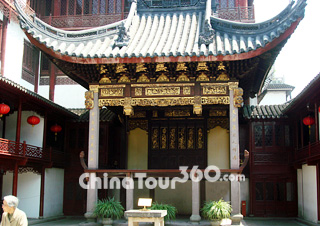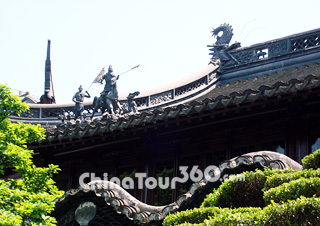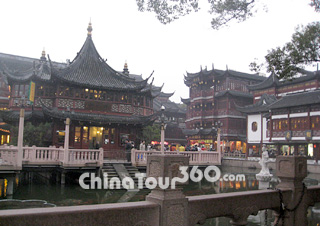 Tour in Yuyuan Garden
Tour in Yuyuan Garden A Long Corridor
A Long Corridor Beautiful Scenery
Beautiful Scenery A Tower, Yuyuan Garden
A Tower, Yuyuan Garden Delicate Sculptures
Delicate Sculptures Shanghai, Yuyuan Garden
Shanghai, Yuyuan Garden
Shanghai Yuyuan Garden is one of the most famous gardens of the Southern Yangtze River style in China. Constructed in 1559 during the Ming Dynasty (1368 - 1644), the garden is the only garden of that period in the old town. It is in the Huangpu District at the city center and neighbors the Old City God's Temple and the Yuyuan Tourist Mart.
Yuyuan Garden was once a private garden of a Ming Dynasty official, Pan Yunduan. He intended to invite his parents to live in this garden after retirement, so he named it Yu Yuan (Yu means safe and peace in Chinese; Yuan means garden). Subsequently in the Qing Dynasty (1644 - 1911), many merchant guilds established their clubs in the garden; teahouses, restaurants and all kinds of outlets also moved in. During the Republic of China (1912 - 1949), many halls in the garden were taken by restaurants and teahouses, and some were even converted to residence houses. From 1956 to 1961, the garden underwent a complete renovation and finally opened to the public in 1961.
The garden covers over 30 mu (4.9 acres), including 6 scenic areas: Sanhui Hall, Wanhua Chamber, Dianchun Hall, Huijing Tower, Yuhua Hall and the Inner Garden. Sanhui Hall consists of the Cuixiu Hall, the Rock of Taihui Lake, the Iron Lions of the Yuan Dynasty (1271 - 1368), Huge Rockery, Yangshan Hall and Sanhui Hall, among which the 9 meter (29.5 feet) high building is the central one in the garden. The Hall was the place where government celebrations were held and also for the local scholars to gather. To the northeast of Sanhui Hall is the Wanhua Chamber. The Wanhua Chamber is decorated with delicate wooden carvings, painted beams and columns, overhanging roofs and open traceries carved with plum blossoms, orchids, bamboo and chrysanthemums – four plants that are considered the gentlemen of plants. In front of the chamber is a 21 meter (about 69 feet) high gingko tree, which is 400 years old and still vibrant with life.
Dianchun Hall lies to the east of Wanhua Chamer, which includes Hexu Hall, Acting-and-Sing Stage, Kuailou Pavilion, Dianchun Hall and the Dragon Wall. Dianchun Hall was constructed during the Qing Dynasty and later became the headquarters of the Xiaodaohui Rebels at the end of the Qing Dynasty. Some weapons, corns and documents of the rebels are still exhibited in the hall. Hexu Hall on the opposite side displays a set of wooden furniture. The furniture, made of banyan roots and carved with phoenix and kylin patterns, is over 100 years old. Walking westward from the Hexu Hall, you reach the Huijing Tower. The Huijing Tower lies in the center of Yuyuan Garden, where you will get a full view of the garden. The Jade Water Corridor winds over the lake in front of the tower and connects it with another tower about 100 meters away. The corridor is the longest one in the classic gardens in the southern Yangtze River areas. The zigzag Sanqu Bridge links Yuhua Hall in the south.
The most famous attraction in Yuhua Hall is the Exquisite Jade Rock which is the treasure of the garden. In the Chinese classic gardens rocks are important ornaments. The ancient Chinese considered rocks that are thin, with a lot of grooves on the surface and penetrated with holes are the most beautiful rocks. The Exquisite Jade Rock is one of the most beautiful in China. Yuhua Hall lies in front of the rock and exhibits some ancient furniture of the Ming and Qing dynasties.
The Inner Garden is at the southernmost part of the Yuyuan Garden. It was built in 1709 and covers 2 mu (52.7 square yards), consisting of the Ancient Stage, Guantao Tower - the highest building in Shanghai during the Qing Dynasty, Keyi Hal, Nine-dragon Pool, and Jinguan Hall.
![]() Yuyuan Tourist Mart
Yuyuan Tourist Mart
Centered on the Yuyuan Garden and Old City God’s Temple, the Yuyuan Tourist Mart area was the political, economic and cultural center in Shanghai from the Yuan Dynasty to the early Republic of China. It is considered the Roots of Shanghai. The mart originated from the Old City God’s Temple Market about 140 years ago and now has already developed into a complex mart comprised of ancient gardens, architectures, shops, restaurants and tourist attractions.
![]() Recommended Route in Yuyuan Garden:
Recommended Route in Yuyuan Garden:
Entrance → Sanhui Hall → Yangshan Hall → Iron Lions → Cuixiu Hall → Yuele Pavilion → Double Lane Corridor → Wanhua Chamber → Relic Hall → Xuepu Study → Dianchun Hall → Acting-and-Singing Stage → Tingli Pavilion → Hexu Hall → Laojun Temple → Huijing Tower → Nine-lion Study → Liushang Pavilion → Sanqu Bridge → Yuhua Hall → Exquisite Jade Rock → Tingtao Pavilion → Hanbi Tower → Inner Garden
![]() Travel Tips:
Travel Tips:
![]() Entrance Fee:
Entrance Fee:
CNY 40 (Apr. 1 to Jun. 30; Sept. 1 to Nov. 30);
CNY 30 (Jul. 1 to Aug. 31; Dec. 1 to Mar. 31)
![]() Opening Hours:
Opening Hours:
08:30 - 17:30 (Mar. 1 to Oct. 31)
08:30 - 17:00 (Nov. 1 to end of Feb.)
![]() Transportation:
Transportation:
A. Bus Routes: Take Bus No. 11, 26, 64, 71, 145, 581, 715, 730, 736, 801, 926, 929, 932, 969, 980 or Fang-Chuan Special Line and get off at Yuyuan stop;
B. Take Subway Line 10 and get off at Yuyuan station.







